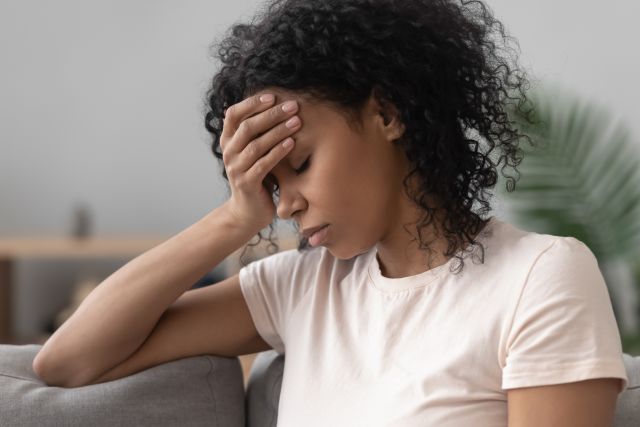Updated on May 31, 2024.
Most people are familiar with the gnawing, stomach-churning feelings that come from having to make a big decision or meet an important deadline. These anxious feelings tend to come and go as issues arise.
But if you have an anxiety disorder, worry and restlessness continue after the stressful situation passes. Anxiety symptoms may get worse over time and can interfere with your life if you don’t address them.
Anxiety is a common condition—and one that is on the rise. According to a 2023 American Psychological Association survey on stress and its related effects, anxiety in the United States has increased by five percent since 2019. In fact, 24 percent of respondents reported having been told by a healthcare provider (HCP) that they have an anxiety disorder.
Much of the rise in anxiety recorded during this time may result from the stress of the COVID-19 pandemic. But even since the pandemic has eased, anxiety maintained a foothold across society.
If you need help understanding what’s causing your worries, a licensed therapist can help. Here’s how to find a therapist, plus information about the signs and treatment options for anxiety.
What are anxiety disorders?
Anxiety is an emotion that involves feeling tense and worried. It sometimes causes physical responses like higher blood pressure. An anxiety disorder, meanwhile, is more than a passing unpleasant feeling. It involves a recurring or long-lasting sense of worry. It may also involve recurring intrusive thoughts.
A person with an anxiety disorder may make changes to their habits or everyday routines or alter their behaviors and activities to avoid situations that worry them. They may have frequent or recurring physical symptoms, like a rapid heart rate, sweating, or trembling.
What are the types and symptoms of anxiety?
There are several essential types of anxiety. They share many common signs, like a pounding heart, trembling, and stomachaches. But each type has a unique set of symptoms. The primary symptoms of each type of anxiety disorder include the following:
Generalized anxiety disorder (GAD): This involves a persistent sense of dread that can get in the way of everyday life. People tend to feel restless, get tired easily, have trouble concentrating, and experience physical symptoms like headaches or trouble sleeping.
Panic disorder: This is characterized by frequent and unexpected panic attacks lasting for at least one month. These may involve sudden, acute bouts of discomfort, fear, or a feeling that something terrible is about to happen. People may also have physical symptoms like heart palpitations, chest pain, or sweating.
Social anxiety disorder: This is marked by an almost uncontrollable fear of social situations. Physical symptoms can include blushing, speaking with a soft voice, having a rigid posture, and having trouble making eye contact. People with social anxiety disorder may have an intense and long-term fear of being judged by other people.
Phobia-related disorders: These involve intense aversions to otherwise harmless circumstances or things. For example, someone with a phobia might worry excessively about flying in an airplane, being exposed to blood, or heights. They may experience intense anxiety if they encounter such things.
Who’s at risk for anxiety disorders?
Some people may be more prone to developing anxiety disorders. Risk factors are different for each type of anxiety disorder, but there are some general risk factors for all forms of anxiety. These include:
- Having been shy or distressed by new situations as a child
- Experiencing trauma or difficult past events
- Being a woman or person assigned female at birth
- Having a personal history of anxiety or other mental health conditions
- Having a family history of anxiety or other mental health conditions
- Having a personal history of substance use disorder
Your HCP may diagnose you with an anxiety disorder after they interview and assess you. During this process, they will likely:
- Look carefully at the symptoms you have and how long they last
- Ask you whether and to what extent your symptoms get in the way of your daily life
- Make professional observations of your demeanor and behaviors
If you’d like to be assessed by a professional, you can find a therapist in your area through Sharecare’s Find a Doctor tool. If you don’t have insurance, some therapists and local health departments offer counseling on a sliding scale to match your budget.
Many colleges and universities also offer free counseling from supervised graduate students who are pursuing degrees in psychology or social work.
How anxiety is treated
There are several effective ways to treat and manage anxiety. These include therapy, medication, and adopting healthy lifestyle habits.
Talk therapy for anxiety
Psychotherapy, a form of counseling also known as talk therapy, can help you understand your illness and learn to manage it. A mental health provider may choose to use any of a variety of types of therapy. Two types in particular are considered particularly helpful for anxiety:
- Cognitive behavioral therapy (CBT): This form of therapy can help you recognize and change behaviors and thoughts that can lead to anxiety and fear.
- Exposure therapy: This helps you learn to face the objects of your anxiety through gentle activities like looking at imagery or learning relaxation exercises.
Medication for anxiety
Medication for anxiety is not a cure, but it can help with symptoms. The three main types of medications typically used for anxiety include:
Antidepressants
The name refers to depression, which is a separate disorder from anxiety. But these drugs can be effective for treating anxiety. In fact, they are typically considered first-line therapies for anxiety disorders.
The most common antidepressants prescribed for anxiety disorders are selective serotonin reuptake inhibitors (SSRIs) and serotonin and norepinephrine reuptake inhibitors (SNRIs).
These drugs work by managing levels of certain neurotransmitters (brain chemicals) in your body. These neurotransmitters (including serotonin and norepinephrine) work in the brain to improve mood, which can lower stress levels. Specifically, the drugs limit how much of these neurotransmitters your body can reabsorb. Less reabsorption means more of them stay in your system.
Though they can be effective, antidepressants can take some time to begin working. Less frequently used antidepressants include tricyclic antidepressants (TCAs) and buspirone.
Anti-anxiety drugs
These drugs, usually benzodiazepines, can act fast to help decrease feelings of worry and panic. They work by stimulating certain cells in your body to release a neurotransmitter that lowers the activity in your nervous system.
Anti-anxiety drugs are usually only used on a short-term basis, however. The longer you take them, the less effective they generally are.
Beta-blockers
These medications are ordinarily used for high blood pressure. They can also treat anxiety by controlling physical symptoms like blushing, sweating, and shaking. They work by slowing down the “fight-or-flight” response. This is the burst of energy and stimulation that people experience when confronted with a stressful or seemingly dangerous situation.
Before stopping or starting any of these medications, be sure to consult with an HCP.
Lifestyle approaches for anxiety
Leading a healthy lifestyle can also help to manage or even lower symptoms. This includes getting regular exercise, eating a healthful diet, and limiting or avoiding caffeine intake.
Remember that caffeine is found in many products besides coffee, including many sodas, chocolate, and tea. Be certain to discuss with your HCP any herbal medications you might be taking or want to take, as they can interact with other medications and may end up worsening your symptoms.
Tips for living with an anxiety disorder
There are a variety of ways to bring down your anxiety level during a stressful situation. Some people find success with an approach known as T.I.P.P. This technique includes four ways to help manage your fight-or-flight response. These steps can help you feel calm again and remind you that you’re safe.
Temperature: When you’re stressed, blood rushes to the organs and muscles that could help you run away. These include your brain, eyes, ears, and legs. That makes you sweat and causes your body temperature to go up. It can also make your heart race.
If you start to panic while you’re at home, you can try bringing your temperature down by putting ice water into a bowl and briefly putting your face into the water. If you know that you’ll be going into a stress-inducing situation, you can try bringing a bottle of frozen water along to press to your face.
Intense exercise: Five minutes of vigorous exercise can help lower your anxiety level. It reduces tension and causes the release of feel-good brain chemicals called endorphins.
Paced breathing: Your breathing speeds up when you’re stressed to help bring more oxygen to your heart and brain. You can try lowering your breathing rate by inhaling through your nose for four seconds, then exhaling for six seconds. Repeat this for one or two minutes.
Progressive muscle relaxation: This involves briefly tensing and then relaxing each muscle group in your body. You can do it while seated or lying down, starting from the top of your body and working your way down.
Your therapist can provide additional relaxation techniques and coping methods for your situation and let you know if any elements of the T.I.P.P. approach might be right for you.
You don’t need to experience anxiety in silence. Get help if worry is keeping you from enjoying life. If you’re experiencing a mental health crisis and need immediate help, call, text, or chat 988 to the 988 Suicide & Crisis Lifeline.







